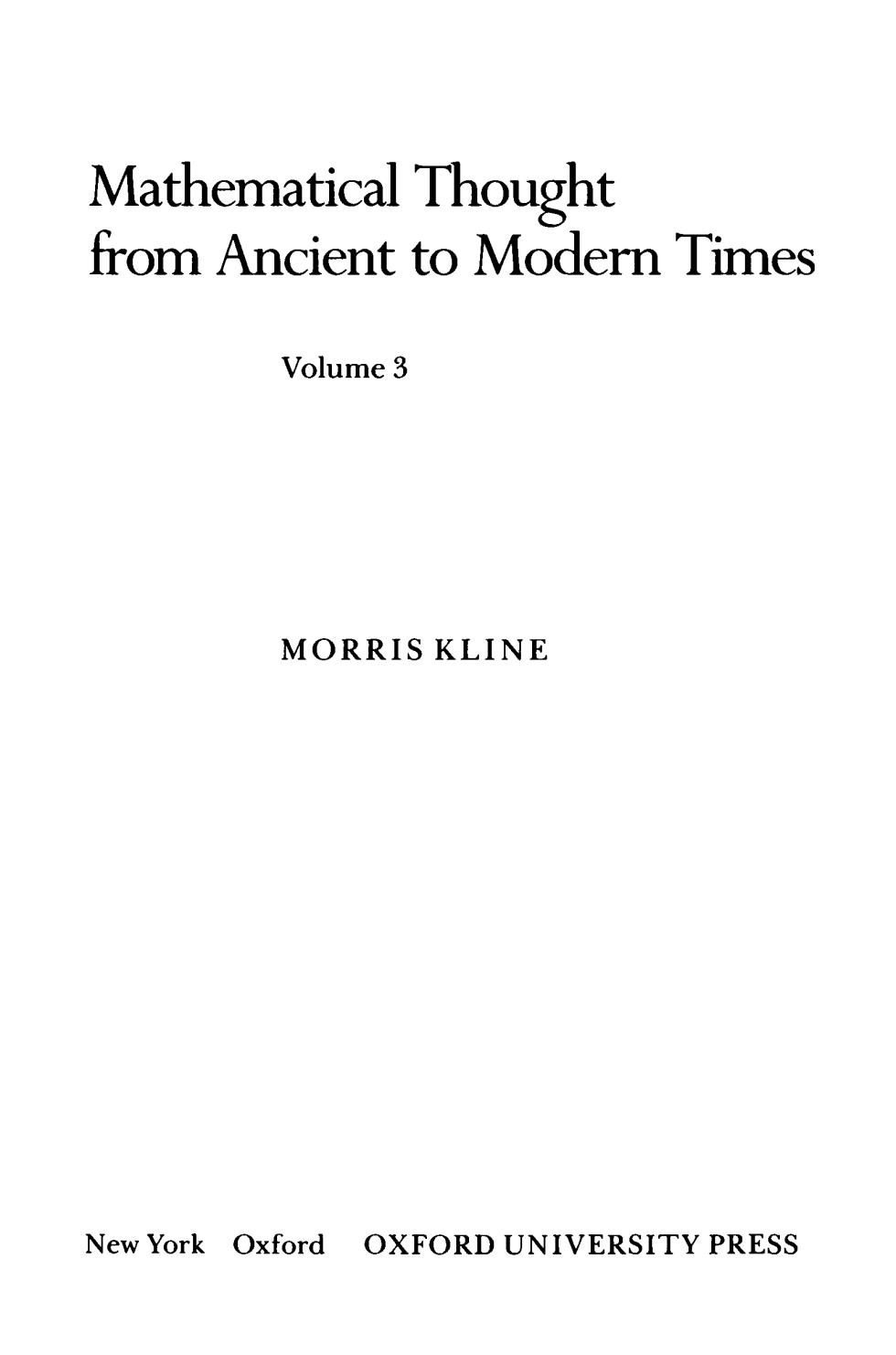
Mathematical Thought from Ancient to Modern Times Volume 3 MORRIS KLINE New York Oxford OXFORD UNIVERSITY PRESS
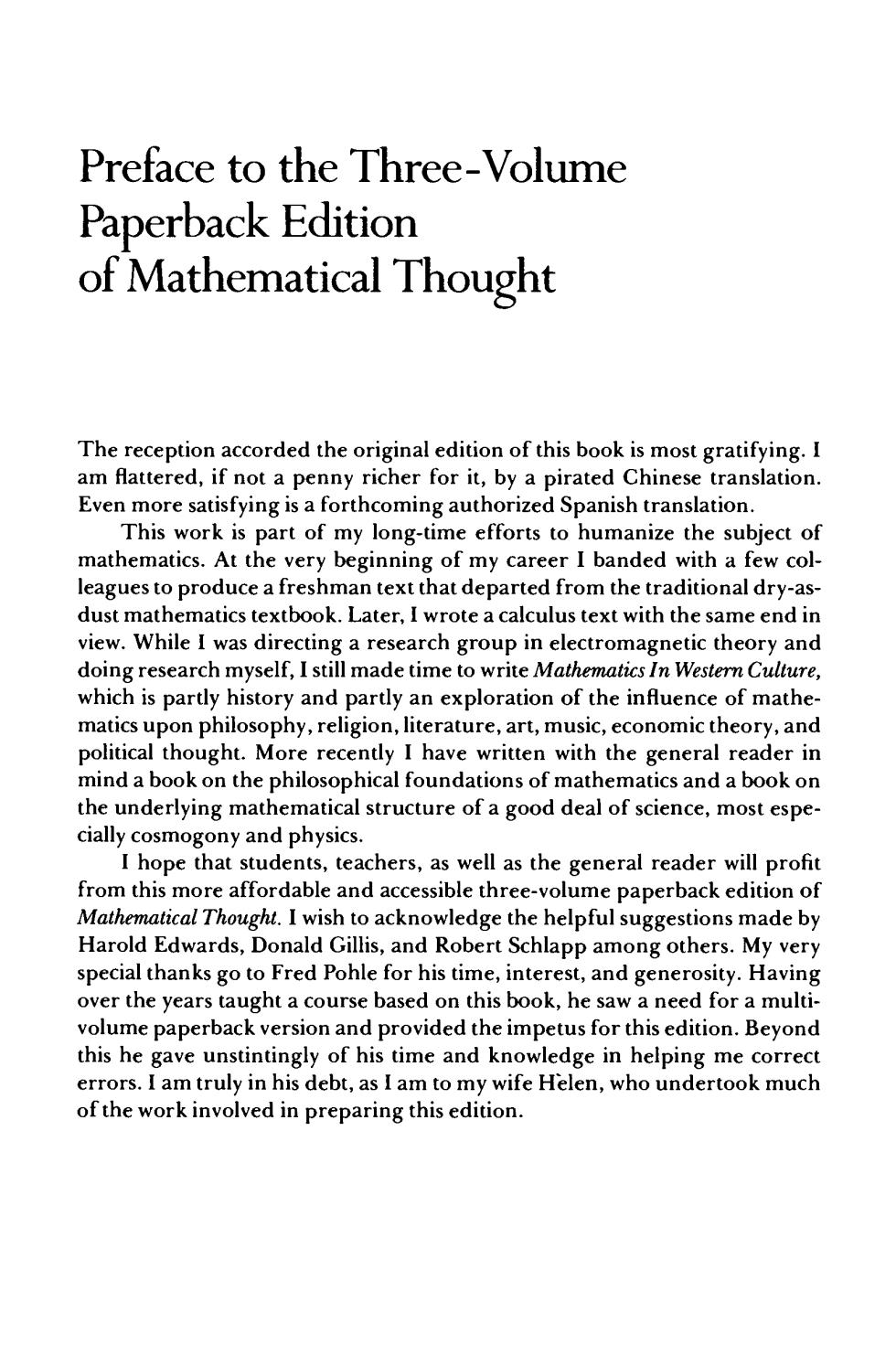
Preface to the Three-Volume Paperback Edition of Mathematical Thought The reception accorded the original edition of this book is most gratifying.I am flattered,if not a penny richer for it,by a pirated Chinese translation Even more satisfying is a forthcoming authorized Spanish translation. This work is part of my long-time efforts to humanize the subject of mathematics.At the very beginning of my career I banded with a few col leagues to produce a freshman text that departed from the traditional dry-as- dust mathematics textbook.Later,I wrote a calculus text with the same end in view.While I was directing a research group in electromagnetic theory and doing research myself,I still made time to write Mathematics In Western Culture, which is partly history and partly an exploration of the influence of mathe- matics upon philosophy,religion,literature,art,music,economic theory,and political thought.More recently I have written with the general reader in mind a book on the philosophical foundations of mathematics and a book on the underlying mathematical structure of a good deal of science,most espe- cially cosmogony and physics. I hope that students,teachers,as well as the general reader will profit from this more affordable and accessible three-volume paperback edition of Mathematical Thought.I wish to acknowledge the helpful suggestions made by Harold Edwards,Donald Gillis,and Robert Schlapp among others.My very special thanks go to Fred Pohle for his time,interest,and generosity.Having over the years taught a course based on this book,he saw a need for a multi- volume paperback version and provided the impetus for this edition.Beyond this he gave unstintingly of his time and knowledge in helping me correct errors.I am truly in his debt,as I am to my wife Helen,who undertook much of the work involved in preparing this edition
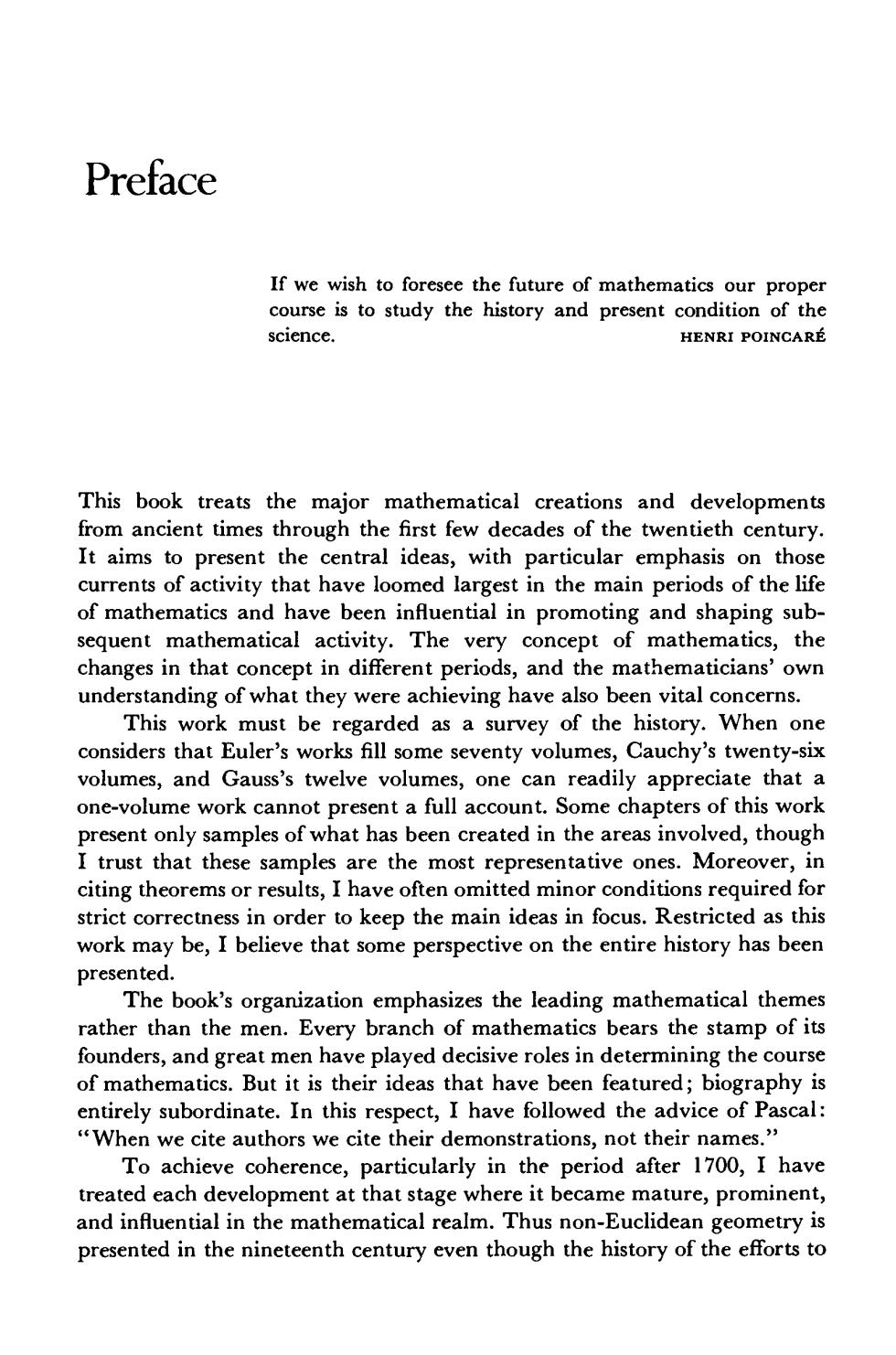
Preface If we wish to foresee the future of mathematics our proper course is to study the history and present condition of the science. HENRI POINCARE This book treats the major mathematical creations and developments from ancient times through the first few decades of the twentieth century. It aims to present the central ideas,with particular emphasis on those currents of activity that have loomed largest in the main periods of the life of mathematics and have been influential in promoting and shaping sub- sequent mathematical activity.The very concept of mathematics,the changes in that concept in different periods,and the mathematicians'own understanding of what they were achieving have also been vital concerns. This work must be regarded as a survey of the history.When one considers that Euler's works fill some seventy volumes,Cauchy's twenty-six volumes,and Gauss's twelve volumes,one can readily appreciate that a one-volume work cannot present a full account.Some chapters of this work present only samples of what has been created in the areas involved,though I trust that these samples are the most representative ones.Moreover,in citing theorems or results,I have often omitted minor conditions required for strict correctness in order to keep the main ideas in focus.Restricted as this work may be,I believe that some perspective on the entire history has been presented. The book's organization emphasizes the leading mathematical themes rather than the men.Every branch of mathematics bears the stamp of its founders,and great men have played decisive roles in determining the course of mathematics.But it is their ideas that have been featured;biography is entirely subordinate.In this respect,I have followed the advice of Pascal: "When we cite authors we cite their demonstrations.not their names.' To achieve coherence,particularly in the period after 1700,I have treated each development at that stage where it became mature,prominent, and influential in the mathematical realm.Thus non-Euclidean geometry is presented in the nineteenth century even though the history of the efforts to
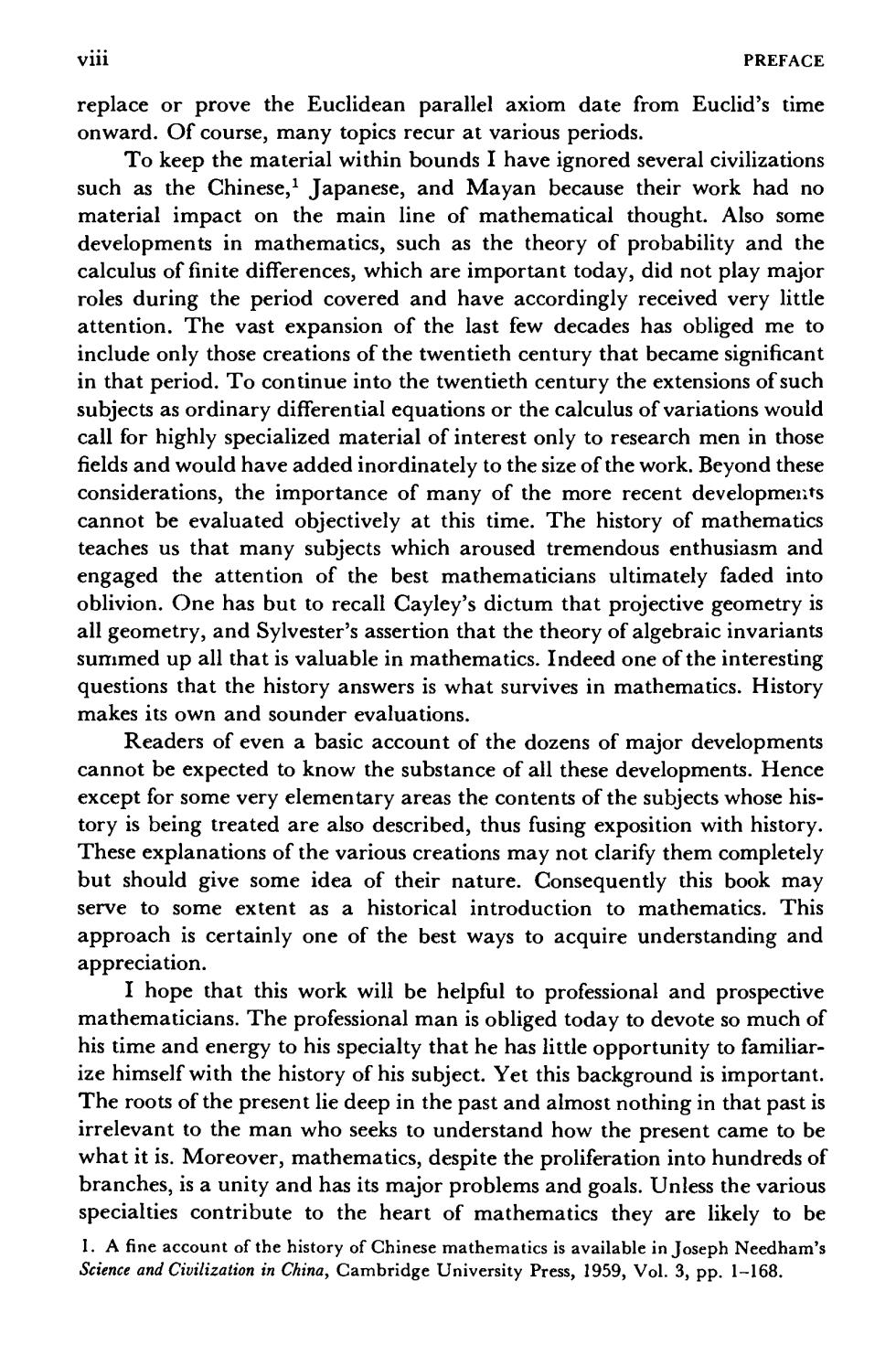
viii PREFACE replace or prove the Euclidean parallel axiom date from Euclid's time onward.Of course,many topics recur at various periods. To keep the material within bounds I have ignored several civilizations such as the Chinese,1 Japanese,and Mayan because their work had no material impact on the main line of mathematical thought.Also some developments in mathematics,such as the theory of probability and the calculus of finite differences,which are important today,did not play major roles during the period covered and have accordingly received very little attention.The vast expansion of the last few decades has obliged me to include only those creations of the twentieth century that became significant in that period.To continue into the twentieth century the extensions of such subjects as ordinary differential equations or the calculus of variations would call for highly specialized material of interest only to research men in those fields and would have addedinordinately h work.Beyond these considerations,the importance of many of the more recent developments cannot be evaluated obiectively at this time.The history of mathematics teaches us that many subjects which aroused tremendous enthusiasm and engaged the attention of the best mathematicians ultimately faded into oblivion.One has but to recall Cayley's dictum that projective geometry is all geometry,and Sylvester's assertion that the theory of algebraic invariants summed up all that is valuable in mathematics.Indeed one of the interesting questions that the history answers is what survives in mathematics.History makes its own and sounder evaluations. Readers of even a basic account of the dozens of major developments cannot be expected to know the substance of all these developments.Hence except for some very elementary areas the contents of the subjects whose his- tory is being treated are also described,thus fusing exposition with history. 'These explanations of the various creations may not clarify them completely but should give some idea of their nature.Consequently this book may serve to some extent as a historical introduction to mathematics.This approach is certainly one of the best ways to acquire understanding and appreciation. I hope that this work will be helpful to professional and prospective mathematicians.The professional man is obliged today to devote so much of his time and energy to his specialty that he has little opportunity to familiar- ize himself with the history of his subject.Yet this background is important. The roots of the present lie deep in the past and almost nothing in that past is irrelevant to the man who seeks to understand how the present came to be what it is.Moreover,mathematics,despite the proliferation into hundreds of branches,is a unity and has its maior problems and goals.Unless the various specialties contribute to the heart of mathematics they are likely to be 16
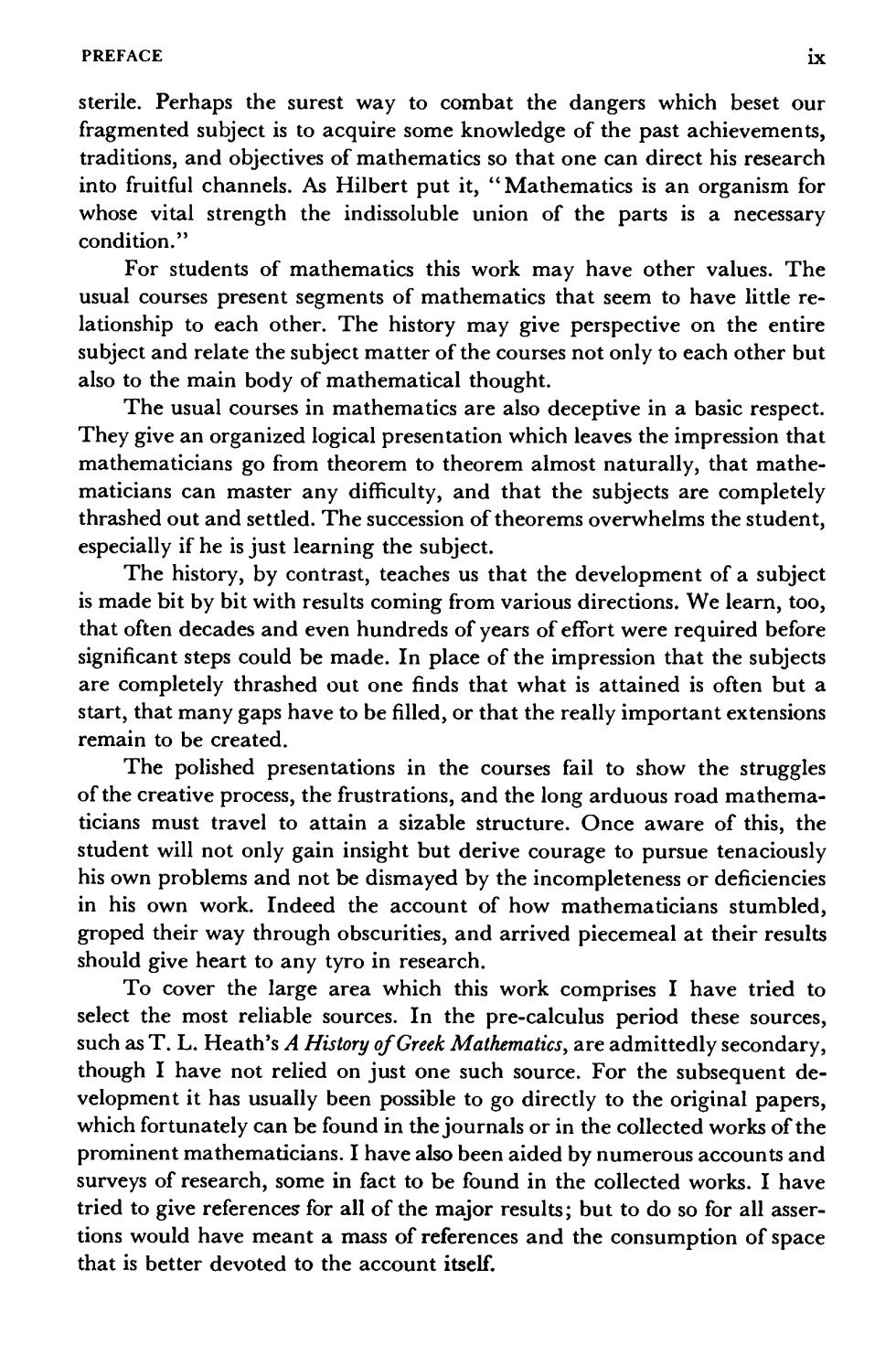
PREFACE ix sterile.Perhaps the surest way to combat the dangers which beset our fragmented subject is to acquire some knowledge of the past achievements, traditions,and objectives of mathematics so that one can direct his research into fruitful channels.As Hilbert put it,"Mathematics is an organism for whose vital strength the indissoluble union of the parts is a necessary condition.' For students of mathematics this work may have other values.The usual courses present segments of mathematics that seem to have little re- lationship to each other.The history may give perspective on the entire subject and relate the subject matter of the courses not only to each other but also to the main body of mathematical thought. The usual courses in mathematics are also deceptive in a basic respect. They give an organized logical presentation which leaves the impression that mathematicians go from theorem to theorem almost naturally,that mathe- maticians can master any difficulty,and that the subjects are completely thrashed out and settled.The succession of theorems overwhelms the student, especially if he is just learning the subject. The history,by contrast,teaches us that the development of a subject is made bit by bit with results coming from various directions.We learn,too, that often decades and even hundreds of years of effort were required before significant steps could be made.In place of the impression that the subjects are completely thrashed out one finds that what is attained is often but a start,that many gaps have to be filled,or that the really important extensions remain to be cre ated The polished presentations in the courses fail to show the struggles of the creative process,the frustrations,and the long arduous road mathema- ticians must travel to attain a sizable structure.Once aware of this,the student will not only gain insight but derive courage to pursue tenaciously his own problems and not be dismayed by the incompleteness or deficiencies in his own work.Indeed the account of how mathematicians stumbled, groped their way through obscurities,and arrived piecemeal at their results should give heart to any tyro in research. To cover the large area which this work comprises I have tried to select the most reliable sources.In the pre-calculus period these sources, such asT.L.Heath's A History of Greek Mathematics,are admittedly secondary, though I have not relied on just one such source.For the subsequent de- velopment it has usually been possible to go directly to the original papers, which fortunately can be found in the journals or in the collected works of the prominent mathematicians.I have also been aided by numerous accounts and surveys of research,some in fact to be found in the collected works.I have tried to give references for all of the major results;but to do so for all asser- tions would have meant a mass of references and the consumption of space that is better devoted to the account itself
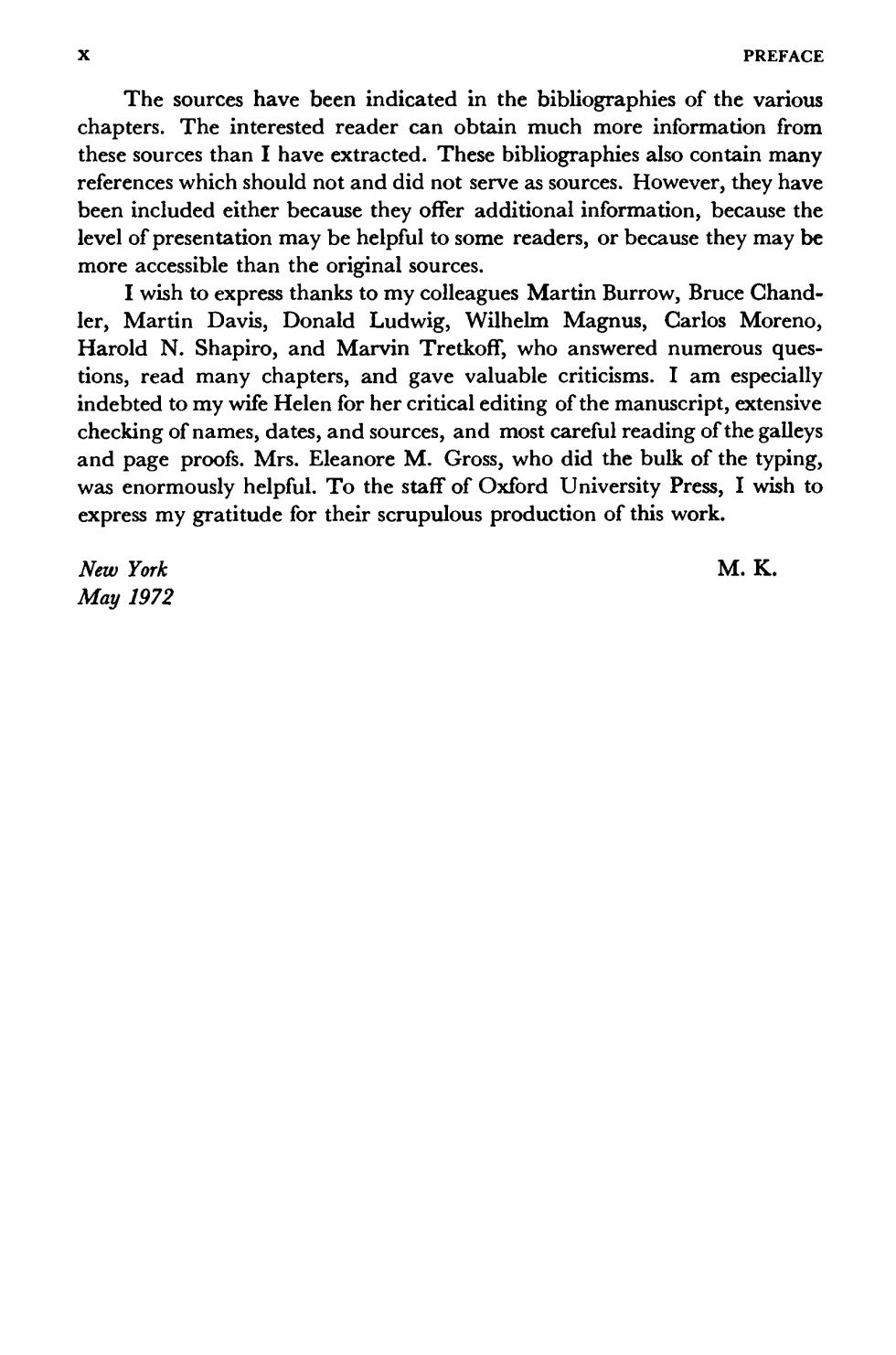
PREFACE The sources have been indicated in the bibliographies of the various chapters.The interested reader can obtain much more information from these sources than I have extracted.These bibliographies also contain many references which should not and did not serve as sources.However,they have been included either because they offer additional information,because the level of presentation may be helpful to some readers,or because they may be more accessible than the original sources. I wish to express thanks to my colleagues Martin Burrow,Bruce Chand- ler,Martin Davis,Donald Ludwig,Wilhelm Magnus,Carlos Moreno, Harold N.Shapiro,and Marvin Tretkoff,who answered numerous ques- tions,read many chapters,and gave valuable criticisms.I am especially indebted to my wife Helen for her critical editing of the manuscript,extensive checking of names,dates,andsources,and most careful reading of the galleys and page proofs.Mrs.Eleanore M.Gross,who did the bulk of the typing, was enormously helpful.To the staff of Oxford University Press,I wish to express my gratitude for their scrupulous production of this work New York M.K. May 1972
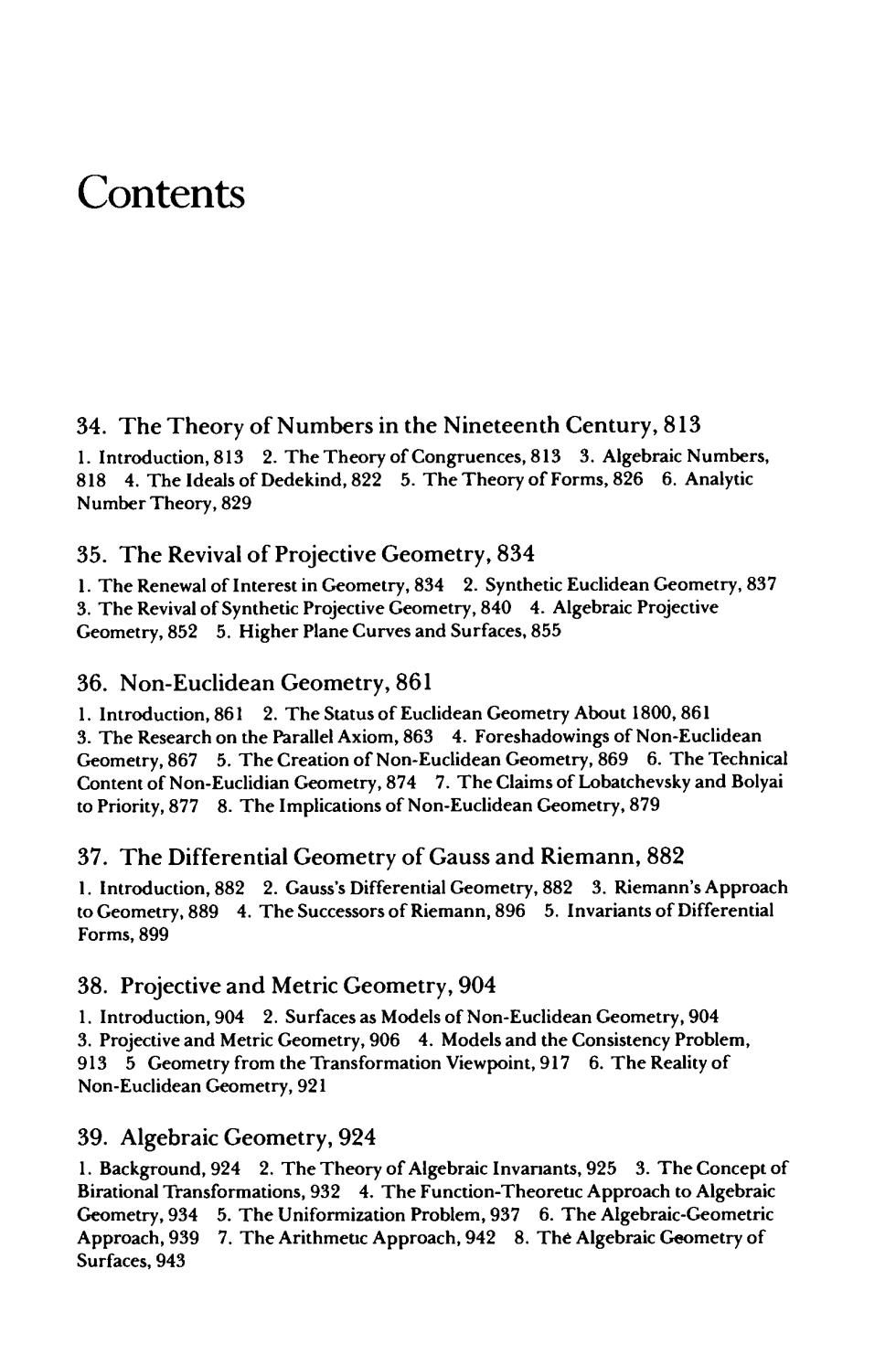
Contents 34.The Theory of Numbers in the Nineteenth Century,813 1.Introduction,813 Number Theory,829 35.The Revival of Projective Geometry,834 1.The Renewal of Interest in Geometry,834 2.Synthetic Euclidean Geometry,837 3.The Revival of Synthetic Projective Geometry,840 4.Algebraic Projective Geometry,852 5.Higher Plane Curves and Surfaces,855 36.Non-Euclidean Geometry,861 1.Introduction,861 2.The Status of Euclidean Geometry About 1800,861 3.The Research on the Parallel Axiom,863 4.Foreshadowings of Non-Euclidean Geometry,867 5.The Creation of Non-Euclidean Geometry,869 6.The Technical Content of Non-Euclidian Geometry,874 7.The Claims of Lobatchevsky and Bolyai to Priority,877 8.The Implications of Non-Euclidean Geometry,879 37.The Differential Geometry of Gauss and Riemann,882 1.Introduction.882 2.Gauss's Differential Geometry.882 3.Riemann's Approach to Geometry,889 4.The Successors of Riemann,896 5.Invariants of Differential Forms.899 38.Projective and Metric Geometry,904 of Non-Euclidean Ge o D ive and M ometry,904 etry,906 4. odels a roblem 913 No-LudldcCcomuy. 39.Algebraic Geometry,924 1.Background,924 2.The Theory of Algebraic Invanants,925 3.The Conceptof Birational Transformations,932 4.Ihe Fu ction-Theoretic Approach to Algebrai Geometry,934 5.The Uniformization Problem,937 6.The Algebraic-Geometric Approach,939 7.The Arithmeuc Approach,942 8.The Algebraic Geometry of Surfaces,943

xii CONTENTS 40.The Instillation of Rigor in Analysis,947 4 The Inte of Analysis 972 41.The Foundations of the Real and Transfinite Numbers,979 al the RealN ber Sys nce n hnite S 99g on he Th 998 9.The Transfinite Cardinals and Ordinals. Status of Set Theory by 1900.1002 42.The Foundations of Geometry,1005 1.The defects in Euclid.1005 2.Contributions to the foundations of proiective Geometry.1007 3.The Fo ndations of Euclidean Ge onal Work,1015 5.Some Open Que 43.Mathematics as of 1900,1023 5 Mathe m3ti sas the Study of Arbitrary Structures,1036 6.The Problem of Consistency,1038 7.A Glance Ahead,1039 44.The Theory of Functions of Real Variables,1040 Mea ns.1050 45.Integral Equations,1052 ction.1052 2.The Beginning ofa Gene eral Th 1056 3.The Work of Theory,1073 46.Functional Analysis,1076 1.The Nature of Functional Analysis,1076 2 The Theory of Functionals,1077 3.Linear Functional Analysis,1081 4.The Axiomatization of Hilbert Space,1091 47.Divergent Series,1096 1.Introduction,1096 2.The Informal Uses of Divergent Series,1098 3.The Formal Theory of Asymptotic Series,1103 4.Summability.1109 48.Tensor Analysis and Differential Geometry,1122 I The Origins of Tensor Analysis,1122 2.The Notion of a Tensor,1123 3 Covariant Differentiation,1127 4.Parallel Displacement,1130 5.Generalizations of Riemannian Geometry,1133

CONTENTS xiii 49.The Emergence of Abstract Algebra,1136 1.The Nineteenth-Century Background,1136 2.Abstract Group Theory,1137 3. The Abstract Theory of Fields,1146 4.Rings,1150 5.Non-Associative Algebras, 1153 6.The Range of Abstract Algebra,1156 50.The Beginnings of Topology,1158 1.The Nature of Topology,1158 2.Point Set Topology,1159 3.The Beginnings of Combinational Topology,1163 4.The Combinational Work of Poincare,1170 5.Combinatorial Invariants,1176 6 Fixed Point Theorems,1177 7.Generalizations and Extensions,1179 51.The Foundations of Mathematics,1182 setThe Re tMche Th ch istic School, 1192 6.The Intuitionist School,1197 malist School,1203 8.Some Recent Developments,1208 List of Abbrevations Index

Publisher's Note to this Three-Volume Paperback Edition Mathematical Thought from Ancient to Modern Times was first published by Oxford University Press as a one-volume cloth edition.In publishing this three-volume paperback edition we have retained the same pagination as the cloth in order to maintain consistency within the Index. Subject Index,and Notes.These volumes are paginated consecutively and,for the reader's convenience,both Indexes appear at the end of each volume